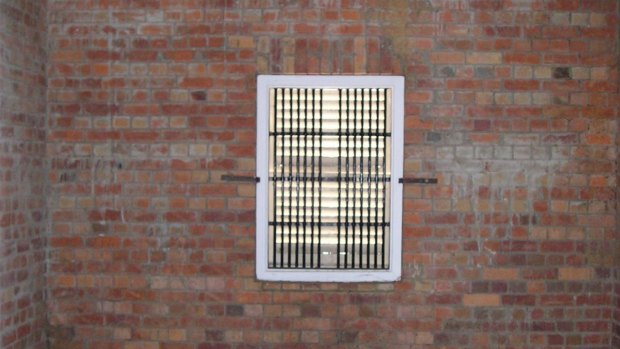This was published 8 years ago
Brisbane's top secret prison cells to be protected in bridge plan
By Tony Moore
Top-secret prison cells in Brisbane where Japanese prisoners of war were interrogated will be preserved if Brisbane City Council buys the Army's Witton Barracks at Indooroopilly for a future car bridge.
Brisbane's residents were never told Japanese prisoners of war were interrogated at Indooroopilly, and the cells are the last of their kind in Australia.

Inside a POW cell at Indooroopilly's Witton Barracks.
Indooroopilly-based councillor Julian Simmonds said he and federal MP Jane Prentice will meet with the federal government's Parliamentary Secretary of Defence Darren Chester next month to make a formal submission to buy the Indooroopilly land.
The three rare Australian interrogation cells remain at Witton Barracks on the Toowong side of the Brisbane River, right beside the Walter Taylor Bridge.
The cells, which held about 15 prisoners, were close to two buildings: Tighnabruaich and Witton House on the Witton Barracks site.
Tighnabruaich is now privately owned, while Witton House has been demolished.
"They are the only prisoner of war cells left in the whole of Australia and they are the ones that have the heritage significance," Cr Simmonds said.
"So they would be protected as part of the process of turning this site in a district park," he said.
"Witton House (at Witton Barracks) ... became the primary interrogation centre for enemy POWs in this country," a Queensland Government historic sites website explains.
"Other important work conducted at the ATIS HQ were the breaking of the Japanese Army's codes in 1943 and the translation of a captured list that allowed the Allies to compile a Japanese Order of Battle."
"The POW cell designs were deemed 'top secret' and were never drawn onto the site plans," the site explains.
Japanese prisoners were being shipped from Port Moresby to Brisbane then sent under guard by train or truck to the Gaythorne POW Transit Camp.
"Individual POWs were taken to the ATIS Camp and placed in a cell prior to interrogation. Interrogation sessions lasted a few days," the site reads.
"The ATIS headquarters at Indooroopilly was the principal interrogation centre within Australia during the war."
The two-hectare Witton Barracks eventually became the Australian Army Women's Service barracks and was most recently used by a University of Queensland regiment until it was closed in 2011.
"Jane Prentice and I have exchanged letters with the Paliamentary Secretary of Defence and we have entered into a negotiation process to secure the site on behalf of ratepayers," Cr Simmonds said.
Brisbane City Council is prepared to bid a sum of money that reflects its value as riverfront parkland, Cr Simmonds said.
"We have explained to the Parliamentary Secretary that this site is zoned for parkland and is zoned a future road corridor," Cr Simmonds said.
"And while ratepayers can't pay market prices we are prepared to pay 'park prices' to preserve the corridor in public ownership," he said.
There is no plan at this stage to build a second bridge across the Brisbane River to duplicate the Walter Taylor Bridge, Cr Simmonds said.
However a decision to buy the heritage-listed army barracks means the corridor is protected.
"The site that is Witton Barracks is an absolute prerequisite for any duplication of the bridge," he said.
Cr Simmonds said the federal government was now prepared to listen to the council's offer after previous approaches since 2009.
"I think this is a real golden opportunity where our stars are aligning and all our ducks are in a row in terms of the support we need."
About 34,000 vehicles a day now drive over the congested Walter Taylor Bridge.
A solution has been sought since April 2010, when Witton Barracks still had 400 Defence Department staff, with about 40 per cent in uniform.